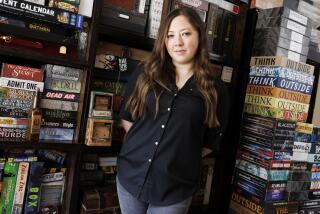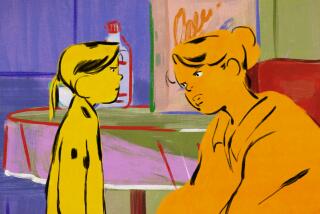The Player: What ‘Fraggle Rock’ has to do with the new mobile game ‘Leonardo’s Cat’
Michael Frith spent the bulk of his career working with the Muppets. Today, the latest project from the semiretired artist has him reimagining history and bringing his expressive, handcrafted characters to the world of mobile gaming.
“Leonardo’s Cat” is the master of puppetry’s first mobile game, but he downplays the shift to the digital world. You see, Frith has always been tinkering with technology.
“One of the things that’s always driven the work that we do is experimentation, trying to see what we can do in and with media we had not worked with before,” Frith says, speaking over the phone from the study in his New York home. “With ‘The Muppets,’ we pioneered things like motion capture.”
Whether he is working with games or puppets, the questions Frith asks himself are the same: “How do you take the place that you are in, the tools that you are given, and find new and interesting and exciting and hopefully beneficial ways to use those tools?”
“Leonardo’s Cat,” released Thursday by Story Toys on Apple’s app store, is a child-friendly game with an educational bent, grownup-worthy brainteasers and the voice of “Star Trek’s” Patrick Stewart as Leonardo da Vinci. Using Frith’s animated designs, the game imagines an alternate history, one where da Vinci and Michelangelo were thieving rivals and a cat was a muse.
Puzzles involve sending the cat into the air and over water, and the game even offers a new theory or two for some long-held riddles. Who, for instance, inspired the Mona Lisa? The game shows us Da Vinci painting his famous work with his cat Scungilli as the model.
That’s one possibility, at least according to the artwork of Frith, who earlier in his career was a principal on “Fraggle Rock.”
“When you think of Leonardo, it immediately conjures images of the great magicians of fiction,” says Frith, whose take on Da Vinci has a Santa Claus-like beard and a baggy blue wizard’s robe.
“He really is the prototypical Merlin, except he was real. He could do just about anything and everything.”
“Leonardo’s Cat” emphasizes the inventor side of the famed painter and scholar. Although there are some creative liberties taken, contraptions in the game are inspired by Da Vinci’s drawings and artwork – his flying machines, for instance, or his cannonball projections. The story involves a feud with Michelangelo, who has taken Da Vinci’s designs for a robot and scattered them around 16th century Amboise, France.
In an effort to recover the automaton, players place Da Vinci’s inventions around the game levels — say the outside of a castle – and direct Scungilli to operate the tools. If there’s a wooden barricade, fire a cannonball. If Scungilli needs to reach a balcony to avoid the perilous water, use a propeller craft -- but watch out for the storm clouds.
It’s a pure puzzle game; the only action involved is deciding which inventions to use and where to put them. Once players are convinced Scungilli can be led to safety, they simply tap a play button and watch the level unfold. But miscalculate the projections of a spring and Scungilli will be left with a nasty headache and the level will start over.
Frith approached the designs, he says, as if Leonardo and Scungilli were in one “of those odd-couple relationships where they’re absolutely dependent upon one another.” The two reminded him of Muppet pals Bunsen and Beaker.
“Thinking of him as a magician, every magician needs a familiar, right? For many magicians the familiar is a cat,” Frith says. “If this is going to be about Leonardo and his cat, you’re immediately thinking about a symbiotic relationship between these two characters. My first reaction was that he’s a magician but also a bit of a mad scientist. Every scientist needs a guinea pig.”
Scungilli is definitely be used as something of an experiment. Some levels give a player multiple springs for Scungilli to jump on but only one kite-like floating device. Plenty of times I sent the cat, who purrs and meows throughout the adventures, into the sea or a thunder cloud.
There is a slight educational aspect. Between levels, players learn little details about Da Vinci’s work, but the $2.99 “Leonardo’s Cat” never felt like a teaching or academic tool. In that sense, Frith says, it reminded him of the work he’s been doing his whole career, including on the development of “Fraggle Rock.”
“It was a show with very deep messages we wanted to get across about the independence of all people and cultures and how dependent we all are on the earth for the gifts that it gives us,” Frith says. “It was a way to try and say some things we felt was important. I see this world of apps as just being a continuation of that.”

Today, Frith spends his free time with No Strings International. The charitable organization makes puppet films and stages puppet workshops for children in traumatic situations around the globe. Recent No Strings projects, for instance, have focused on the conflict in Syria.
Although “Leonardo’s Cat” is decidedly less serious, it allowed Frith to dip into the world of apps. He’s excited by the transformative potential of the medium, noting that cellphones are often accessible even in war-torn areas.
“People have cellphones,” Frith says. “This stuff is there. This medium, which was once for the few and the privileged, is now ubiquitous, practically. To be thinking about ways one can take these messages and reinterpret them to help people in these dire situations -- that can be cool.”
Even though this is the first work Frith has done on an app, it’s not his first game. In a way, “Leonardo’s Cat” brings his career full circle. One of his first jobs in the early ‘60s was working with Dr. Seuss on his “Beginner’s Books” series.
“One of the early things I did back in the Dr. Seuss days was develop some in-school games based on the Seuss work that we were doing,” he says. “Today they would look positively ludicrously primitive, but at the time they were great fun.”
“It’s not medicine,” he says. “This stuff is wonderful. It’s exciting. It’s amazing. Kids love to soak up facts.”
More to Read
The biggest entertainment stories
Get our big stories about Hollywood, film, television, music, arts, culture and more right in your inbox as soon as they publish.
You may occasionally receive promotional content from the Los Angeles Times.











